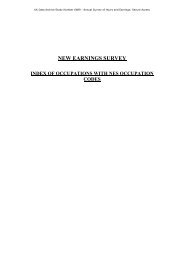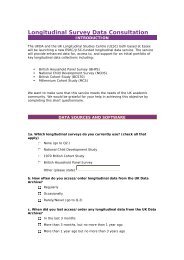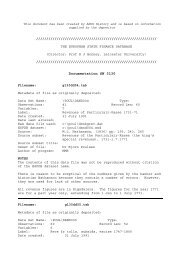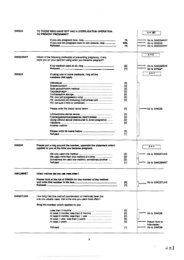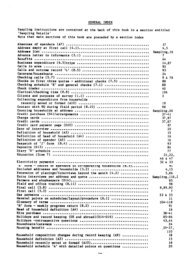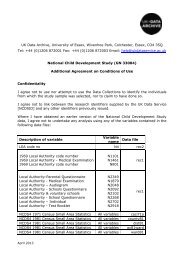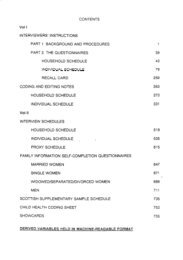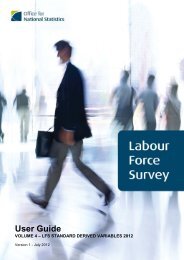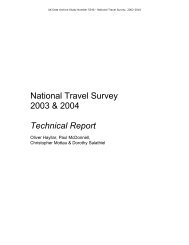ESDS Annual Report, 2008-2009
ESDS Annual Report, 2008-2009
ESDS Annual Report, 2008-2009
Create successful ePaper yourself
Turn your PDF publications into a flip-book with our unique Google optimized e-Paper software.
Table 3b Data <strong>Report</strong>s generated for international macrodata via Beyond 20/20<br />
Total number of Data <strong>Report</strong> downloads Total<br />
2007-<strong>2008</strong>* 91,205<br />
<strong>2008</strong>-<strong>2009</strong> 120,627<br />
*the 2007-<strong>2008</strong> figure includes Data <strong>Report</strong>s generated only for the period 1 September 2007 - 31 July <strong>2008</strong>, to reflect when recording of this information began<br />
Table 4 <strong>ESDS</strong> International macrodata accessed via Beyond 20/20<br />
Total number of data analysis sessions Individual users<br />
2007-<strong>2008</strong> 105,587 6,340<br />
<strong>2008</strong>-<strong>2009</strong> 90,236 6,674<br />
Table 5 Use of Nesstar online microdata browsing and analysis service<br />
Total number of data analysis sessions Individual users<br />
2007-<strong>2008</strong> 16,995 8,719<br />
<strong>2008</strong>-<strong>2009</strong> 17,944 8,419<br />
A further complication arises from the fact that any of<br />
the microdata collections enumerated in Table 3a can<br />
also be redistributed locally to students using the data<br />
for instructional purposes.<br />
International macrodata are supplied to users via the<br />
Beyond 20/20 software interface based at Mimas. This<br />
allows the user to create tabular statistics in the form<br />
of data reports, as well as graphical outputs, similar<br />
to those of Nesstar described above. These can also<br />
be downloaded to a local device. Table 3b reports the<br />
number of data report downloads.<br />
It is important also not to overlook the access given to<br />
registered users to online qualitative data collections.<br />
These consist mostly of open-ended interviews and<br />
responses and are not really downloaded or saved<br />
in the same ways as the structured data collections<br />
mentioned thus far. Users can download related audio<br />
and image files from the collection but more usually<br />
might cut and paste snippets of text, thus making<br />
measurement problematic.<br />
With this outline of data access methods established,<br />
Table 3a shows that overall the number of microdata<br />
collections delivered to users continued the increasing<br />
trend of previous years, breaking the 50,000 figure for<br />
the first time. Within this figure, the basic distribution<br />
of data access between the various services supporting<br />
microdata also remained broadly the same, although<br />
the demand for <strong>ESDS</strong> Qualidata seems to have<br />
increased very significantly. The available statistical<br />
information would therefore suggest that after a<br />
period of year-on-year increase in usage during<br />
the first six years of <strong>ESDS</strong>, the apparent plateauing<br />
reported last year appears to have been temporary. It<br />
is important to note that these figures do not include<br />
counts of data redistributed for use in classrooms.<br />
Unfortunately, these data are notoriously difficult<br />
to capture since lecturers do not always return class<br />
registrations in a timely fashion. As a result figures are<br />
always at best approximate, but these add roughly<br />
a further 50,000 users accesses, in broadly the same<br />
proportions by service as shown in Table 3a.<br />
E C O N O M I C A N D S O C I A L DATA S E RV I C E A N N UA L R E P O RT AU G U S T 2 0 0 8 – J U LY 2 0 0 9 2 5




